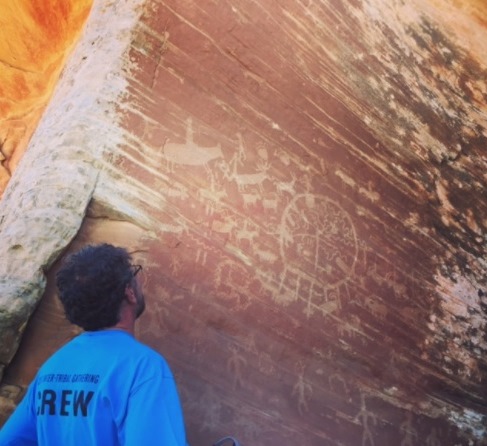Last week, I had the honor of attending the Inter-Tribal Gathering in support of the Bears Ears National Monument, an annual event held in southern Utah by the five tribes who have been supporting the monument - the Hopi Tribe, Navajo Nation, Ute Indian Tribe, Ute Mountain Ute, and Zuni Pueblo. The gathering this year came at a crucial time, held on the very weekend that Interior Secretary Ryan Zinke sent his recommendation to President Trump advising him to shrink and reduce protections for the Bears Ears National Monument. The recommendation is part of Trump’s broader attack on our public lands under the guise of “reviewing” monuments designated since 1996. This review is nothing more than a thinly veiled effort to allow fossil fuel and other extractive industries access to these lands - threatening to take these hugely popular public lands out of the public’s hands and deliver them swiftly to Trump’s corporate friends for drilling and mining.

Group picture from the 2017 Inter Tribal Gathering in support of the Bears Ears National Monument.
In the case of Bears Ears, the land protected by the National Monument is of particular cultural and spiritual relevance to many Native American tribes in the region. The five tribes listed above, who had been working for years to preserve this region, formed the Bears Ears Coalition in 2015 to encourage President Obama to designate it as a national monument, protecting the more than 100,000 archaeological and cultural sites located within the area. That coalition is now supported by more than 30 tribes with ancestral, cultural and contemporary ties to the region.

Dan Ritzman with the Sierra Club, views the pictographs on Walnut Knob in Bears Ears National Monument.
During the Inter-Tribal Gathering this year, I was able to take a hike in the monument with Willie Grayeyes, the Chairman of the Board of Utah Dine Bikeyah, a non-profit dedicated to "healing of people and the earth by supporting indigenous communities in protecting their culturally significant, ancestral lands.”

The author with Willie Grayeyes, Chairman of the Board of Utah Dine Bikeyah in front of Walnut Knob in the Bears Ears National Monument.
As we hiked up a steep hill above the campsite of the gathering, we came upon a large rock with beautiful, detailed pictographs etched into it’s side - possibly done by people thousands of years ago. And around the rock we found dozens of shards of pottery and stone tools scattered in on the ground. They were everywhere!

Pottery and tool shards seen on our hike - there were so many!
As we stood in the shadow of Walnut Knob, Willie spoke to us about the sacredness of this land, land that his people have come to and have lived in for thousands of years. He said “this is our church.” He showed us plants that served all the purposes they need - medicine, food, tools, shelter - saying the land also served as a “subsistence grocery store.” We talked about why the federal government would undo protections for something so sacred. We were joined by Nickolaus Lewis, a tribal Council Member from the Lummi Nation, who had traveled to the tribal gathering from Washington state to deliver a letter of support from the Lummi to the Coalition in support of Bears Ears. Nickolaus is a veteran and a community leader, and he stressed the importance of maintaining protections for land considered so sacred by so many. He asked, would the federal government undo protections for Arlington National Cemetery? As we all walked down the hill together, happening upon relic after relic, find after find of pottery and cultural history, the question felt particularly apt.

Willie Grayeyes of Utah Dine Bikeyah, Nickolaus Lewis, Council Member of the Lummi Nation, and Wayne Hoskisson with the Sierra Club Utah Chapter talk about Bears Ears in the shadow of Walnut Knob in the monument.
It is why Sierra Club was quick to stand with the Inter-Tribal Coalition in their rebuke of Zinke’s recommendation on Monday to shrink the monument and to ask Congress to decide how the lands will be managed. President Obama has already decided - and the tribes have already come to consensus that strong protections are what this area deserves. Zinke cannot continue to publicly claim he listened to the tribes, while simultaneously refusing to give them equal hearing, and concurrently undermining their years-long work to establish this monument. Zinke claims he respects the tribes and wants to keep public lands in public hands. Then he should do just that - push to keep the Bears Ears National Monument fully intact and held in public hands, rather than auctioned off to the private interests eager to frack, drill and mine it.
I hope you’ll join us in standing with the tribes and in support of all public lands. This is about not just protecting our cherished wild spaces, but about justice, about defending the small step our country took towards healing centuries of deep injustice when President Obama listened to the tribes and designated the Bears Ears National Monument. We will be showing up wherever Secretary Zinke goes this summer to remind him how broad the public support is for supporting the tribes, and for maintaining our national monuments and all public lands. Keep your eyes peeled for his next stop in your state, and grab your sign and come meet us!

House On Fire, one of over 100,000 cultural and archaeological sites in the Bears Ears National Monument.